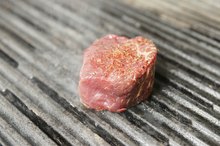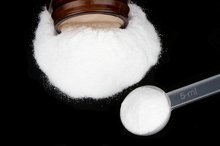How Much Creatine Can Your Muscles Absorb?
Creatine is a naturally-occurring amino acid produced by the liver, kidneys and pancreas. It is also found in various foods. During high-intensity exercise, the body uses a derivative of creatine for energy. Athletes and body builders consume creatine supplements to increase lean muscle mass and improve athletic performance. However, there is some controversy as to how effective creatine supplements are in improving athletic performance.
Creatine in the Body
Creatine is made from amino acids, the components of protein. Creatine is converted into creatine phosphate in the liver and is stored in red muscle tissue. During weight lifting, sprinting or another intense activity of short duration, creatine phosphate is converted into adenosine triphosphate, or ATP, the body’s major energy source.
Creatine Dose
How Much Creatine Is in Red Meat?
Learn More
Creatine supplements are not recommended for children younger than 19. Adults desiring to improve athletic performance should limit consumption to 5g four times daily, or 20g each day. Adults wishing to maintain muscle mass and athletic performance should limit consumption to 2-5g each day. There has been limited evidence that creatine is helpful in reducing cholesterol; 20-25g each day for five days followed by 5-10 g each day thereafter is appropriate. Speak with your doctor before using creatine to treat high cholesterol.
Is Creatine Effective?
Creatine increases your body’s level of ATP, thus giving you more energy to engage in physical activity. According to Vanderbilt University, creatine’s efficacy depends on your diet, regular level of exercise and frequency of exercise. Creatine supplements are most effective when natural creatine level is low. Consume creatine with a carbohydrate, such as fruit juice or a starchy food, to increase efficacy.
Available Forms and Dietary Sources
Is Creatine a Safe Supplement for Teenagers?
Learn More
Creatine is available in powder, capsule and liquid form. Although our bodies produce about half the creatine our body needs to perform athletic activities, the other half comes from dietary sources. Fish, especially salmon and herring, red meat and wild game, such as deer and elk, are the best sources of creatine.
Related Articles
References
Writer Bio
Harper Jones has been a freelance writer since 2007. Her work has appeared in "Zink! Fashion Magazine," "emPower Magazine" and the "Washington Post." She has also published several health and fitness e-books and a book of short stories. Jones graduated with a Bachelor of Arts in English and health sciences and currently works as a yoga teacher.








